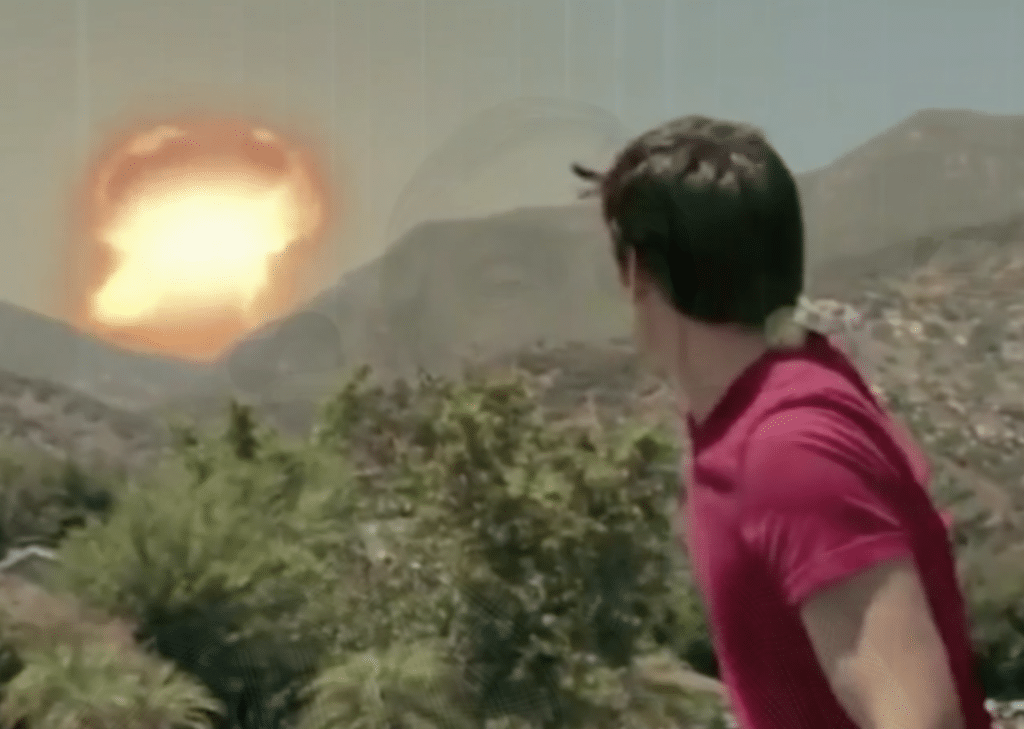Twenty years after 9/11, terrorists could still go nuclear
By Matthew Bunn | September 16, 2021
 A scene from a Ventura County, California public service video on preparing for and responding to a nuclear terrorism event.
A scene from a Ventura County, California public service video on preparing for and responding to a nuclear terrorism event.
As Americans reeled after the 9/11 attacks 20 years ago, one question was at the front of many minds: Could even worse be coming? If the terrorists who attacked on September 11 had a crude nuclear bomb on the plane, it wouldn’t have been just the twin towers—the whole lower half of Manhattan could have been turned to rubble and ash, with hundreds of thousands dead and injured.
Unfortunately, that possibility was all too real. Investigations after the attacks uncovered focused al Qaeda efforts to get nuclear, biological, and chemical weapons. The nuclear program reported directly to Ayman al-Zawahiri, now the leader of the group, and got as far as carrying out crude but sensible conventional explosive tests for the bomb program in the Afghan desert. Weeks before 9/11, Osama bin Laden and Zawahiri met with two senior Pakistani nuclear scientists and discussed how al Qaeda could get nuclear weapons.
But that was then. Today, both al Qaeda and another major jihadist terror group, the Islamic State, have suffered tremendous blows, with their charismatic leaders dead and many others killed or captured. A US-led counterterrorism coalition destroyed the Islamic State’s geographic caliphate in Iraq and Syria. In recent years, many terrorist attacks have not been much more sophisticated than driving a van into a crowd. Al Qaeda has not managed to carry out a single successful attack in the United States since 9/11. Is a terrorist nuclear attack still something to worry about?
The short answer, unfortunately, is “yes.” The probability of terrorists getting and using a nuclear bomb appears to be low—but the consequences if they did would be so devastating that it is worth beefing up efforts to make sure terrorists never get their hands on a nuclear bomb’s essential ingredients. To see the possibilities, we need to look at motive, capability, and opportunity.
Motive. Violent Islamic extremists desperately want to strike back at the “crusader forces” who have inflicted such punishing blows on their organizations. And both the Islamic State and al Qaeda would like a spectacular action to put them firmly back at the forefront of the violent Islamic extremist movement. Years ago, al Qaeda spokesman Sulaiman Abu Ghaith argued that because Western actions had killed so many Muslims, al Qaeda had “the right to kill four million Americans, one million of them children.” That kind of hatred still festers. (Abu Ghaith is serving a life sentence in a US prison.)
Nuclear explosives are only one of the paths to mass slaughter that terrorists have pursued. Nuclear efforts must compete for terrorists’ attention with tried-and-true conventional weapons, biological weapons—whose dangers the pandemic has highlighted—chemical weapons, and more. Many of these other types of weapons would be easier for terrorists to acquire, and so their use may be more likely. But the history-changing power of a mushroom cloud rising over a major city has proved attractive to terrorists in the past and may again.
Capability. Government studies make clear that if a sophisticated, well-funded terrorist group got hold of the needed plutonium or highly enriched uranium (HEU), they might well be able to put together a crude nuclear bomb. Unfortunately, it does not take a Manhattan Project to build a bomb, when you have weapons-usable fissile material. Indeed, the group needed to make a crude bomb might not have a footprint much bigger than the 9/11 attackers had. Despite the enormous destruction that has been rained on al Qaeda and the Islamic State over the last 20 years, a cell of terrorists could be working on a nuclear project even now, somewhere far from US attention and drone strikes.
The intense counterterrorism campaigns of the last two decades have surely reduced terrorists’ ability to plan and carry out such a complex effort. But we simply do not know what capability might remain. The Taliban’s rapid return to power in Afghanistan could add to that capability, making that country a terrorist haven again—but there are many other largely ungoverned or terrorist-controlled places where such a project could be undertaken.
And the capability side of the equation can change at remarkable speed. In January 2014, the US intelligence community did not mention the Islamic State in its annual assessment of threats to US security. By summer, the group had seized much of Iraq and Syria and declared a global caliphate.
Opportunity. Fortunately, around the world, security for plutonium and HEU is far better than it once was, making it far harder for terrorists to get their hands on the needed ingredients for a bomb. More than half of all the countries that once had such material on their soil have gotten rid of it. While stolen HEU or plutonium was once showing up in parked cars and airplane luggage racks in Europe, there hasn’t been a major seizure of potential nuclear bomb material for a decade now.
Nevertheless, with the Obama-era nuclear security summits now far in the rearview mirror, the momentum of nuclear security improvement has slowed. There is still a need to ensure that nuclear weapons, materials, and facilities are protected against the full range of plausible threats—especially from insiders, who appear to pose the biggest nuclear security problem. The rise of domestic violent extremists in the United States and other advanced democracies makes the insider threat even more challenging. There is still a need for realistic tests and assessments of nuclear security systems’ real capabilities against intelligent adversaries looking for ways to beat them. And there’s still a need to strengthen nuclear security culture—to make sure the staff and guards at nuclear facilities are giving security the priority it needs, day-in and day-out.
If terrorists ever did manage to turn the heart of a modern city into a smoldering radioactive ruin, they would change history. The economic, political, and social consequences would reverberate far and wide. Fears that it could happen again—possibly stoked by terrorist claims that they had more bombs already hidden in cities and would detonate them unless their demands were met—could lead people to flee major cities. The reactions after 9/11—a more aggressive US foreign policy, racist animosity, expanded government powers, cutbacks in civil liberties—would be expanded manyfold, particularly once people realized that the material for such a bomb could be hidden in any suitcase.
President Biden has warned of these dangers. Now is the time for him to act. Despite the many other priorities on his desk, it is time for him to launch a new, expanded nuclear security initiative, working to ensure that nuclear stockpiles worldwide are secure and accounted for to the highest standards, that major obstacles are placed in the path of nuclear smugglers, that states are deterred from helping terrorists with nuclear, biological, or chemical weapons, and that terrorist nuclear plots are found and stopped. The risk of a nuclear 9/11 will persist as long as high-capability terrorists and the materials needed to make a nuclear bomb both exist in the world.
Together, we make the world safer.
The Bulletin elevates expert voices above the noise. But as an independent nonprofit organization, our operations depend on the support of readers like you. Help us continue to deliver quality journalism that holds leaders accountable. Your support of our work at any level is important. In return, we promise our coverage will be understandable, influential, vigilant, solution-oriented, and fair-minded. Together we can make a difference.
Keywords: 9/11, Al Qaeda, Ayman al-Zawahiri, Islamic State, Osama bin Laden, nuclear terrorism
Topics: Nuclear Risk, Nuclear Weapons
















An article pointing out China has increased its arsenal, from very small, to bigger, Pakistan has a few hundred, and US/Russia has 7200+, plus a few thousand big warheads not currently attached to a warhead. A documentary I watched 10 yrs ago showed a mid level Russian officer ready to sell. These terrorists are 100% the result of US/Russia’s old war nuclear warhead proliferation. Just 9/15/21, we are advancing our ‘strategy’ to include nuclear powered submarines with nuclear warhead UK, and Australia, a non-signatory of ‘no new’ pledge. By my reckoning, the US is still way out in front for… Read more »
Yes, if they have help from a nuclear armed country, not really if not. To make even the simplest nuclear bomb requires great skill / the right materials, Inc tampers / lenses / and the highly enriched UR or PL, plus the knowledge of how to put it all together in the right way so that it works, triggers alone can make the difference between it working or not, this is beside having the right amount and yield of fuel. Then there is the contamination risk even if you had all the ingredients, the chances of becoming ill and dying… Read more »